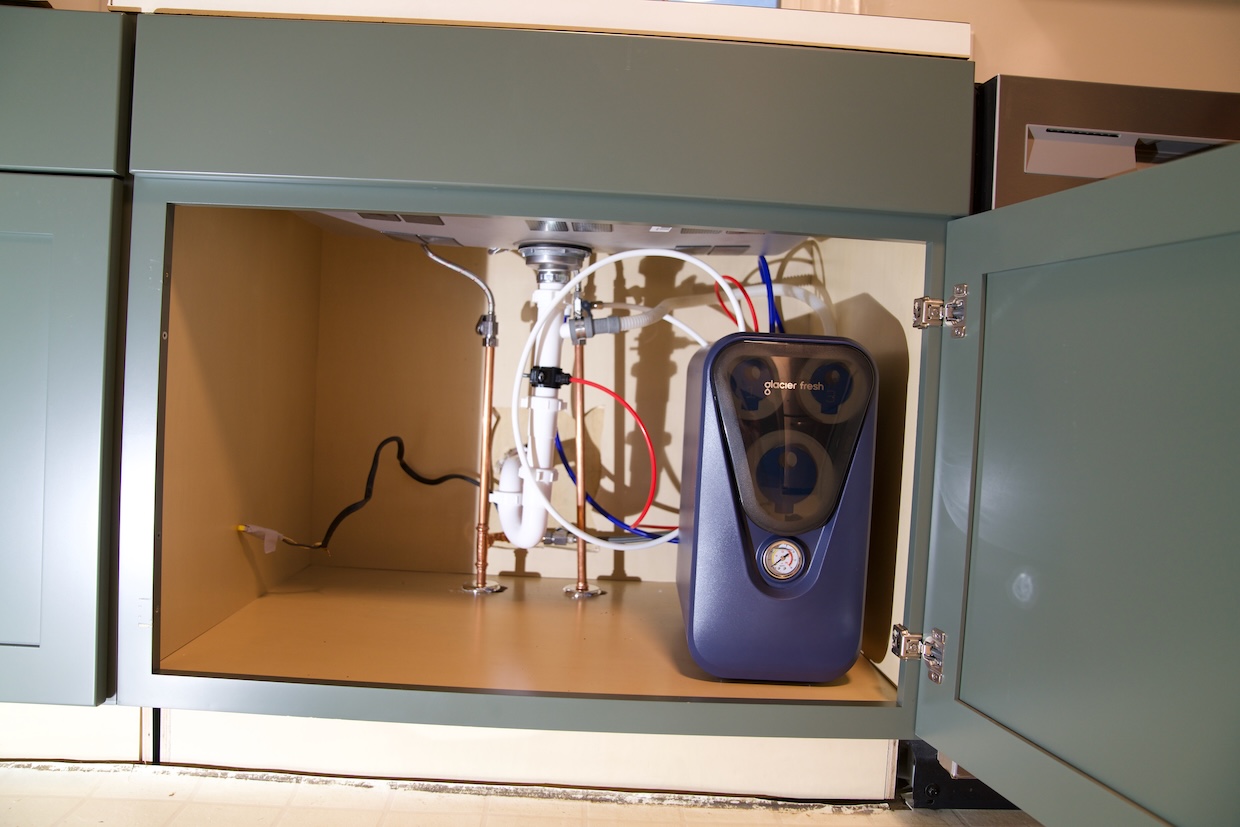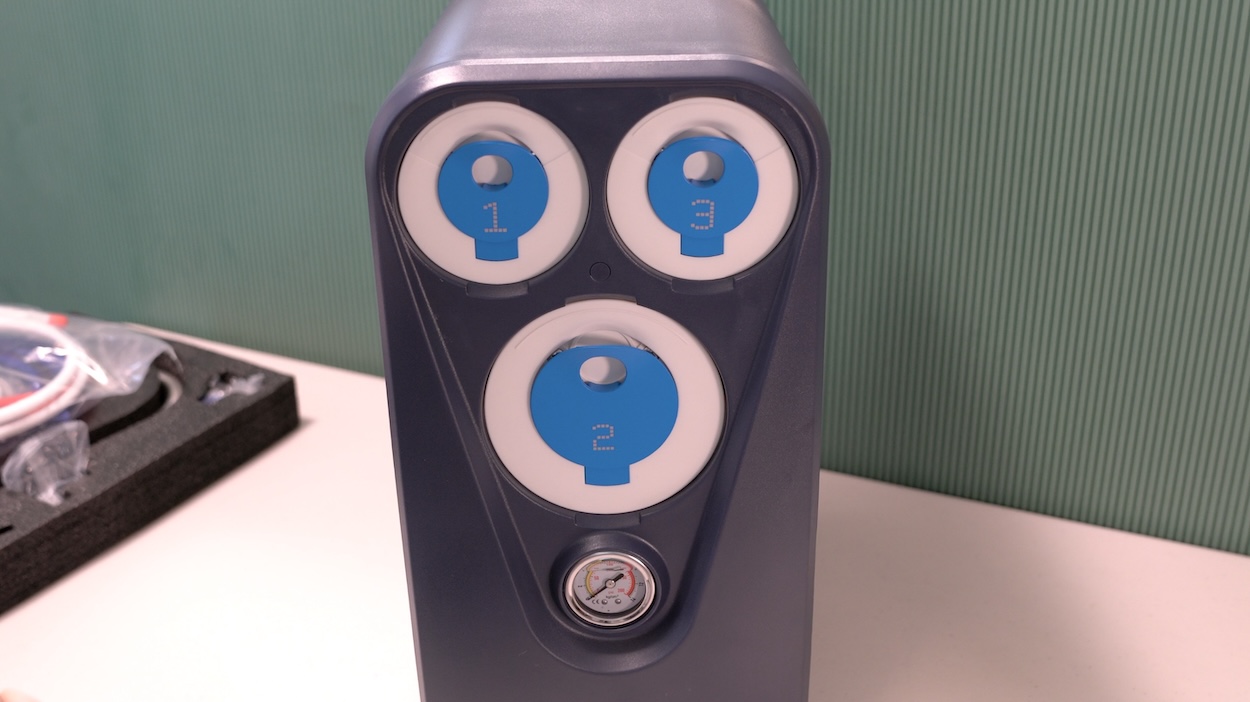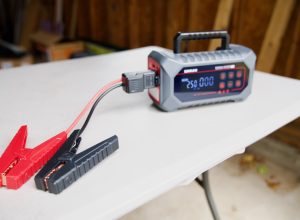Nowadays we keep hearing about water contaminants when watching the news. Tap water was undergoing treatment but there might be a variety of contaminants. They can come from different sources, like aging infrastructure, agricultural runoff, or industrial discharges. We also hear more about PFAS, microplastics, and pharmaceutical residues. Therefore, many people choose to buy water bottles or install home filtration systems in their home. I was using some countertop water purifiers as installing an under-sink RO system might be complicated. I received the GLACIER FRESH GFU03 for this review and this has changed my opinion quite a bit.
Disclosure: We received the system as a courtesy for review purposes. However, the review is intended to provide honest, unbiased insights about the product, based on personal experiences and observations.
Tankless and Space-Saving Design
The system features a tankless design that significantly reduces its footprint. Specifically, it measures 13.58 inches (L) x 8.27 inches (W) x 16.54 inches (H), so I have no problem fitting it under my sink cabinet. I also like the tankless design because the water remains fresh and pure until dispensed.

Another huge advantage of the system is that it doesn’t require electricity. Unlike many systems that rely on electric pumps, the GLACIER FRESH uses existing pressure to push water through filters and up to the faucet. Therefore, installing the whole system becomes much more simplers and suitable for DIYers. My version is the Elite and it took me less than 2 hours to follow the instructions and install the system. There is no plumbing experience needed and you just need to drill one hole on the drain pipe. However, there are 2 times that water leaked out. The first leak happened when I installed the feed water adapter on my Brasscraft valve; This can be fixed by adding an additional gasket to the nut of the adapter. The 2nd leak happened at the quick connector of the blue water tube connecting to the hose of the faucet; I readjusted the connection and somehow this was fixed, however, I am still concerned this could be leaked again in the future. They could have removed the point of failure and made a seamless connection between the port and the faucet.
High Capacity and Efficiency
The system boasts an impressive 800 GPD (Gallons Per Day) capacity, that means it can produce up to 0.6 gallons of purified water per minute. This high flow rate allows us to fill a cup of water in just around 5 seconds. Besides, it features a 3:1 pure-to-drain ratio, so it drains just one cup of wastewater for every 3 cups of purified water.

The tankless system might take longer to dispense water but it is more than enough for most families. Since its operation is based on pressure, the flow rate depends on household water pressure rather than an active pump. Therefore, it doesn’t make loud noises like my previous water purifier. This is much more silent and doesn’t require any electric connection.
The only issue with the system is that I notice a drop in cold water pressure. This is because the system may have a small internal pressure tank or have internal components that divert a portion of the incoming water for processing or to maintain internal system pressure, even when the pure water faucet is not in use. This diversion of water can impact the flow rate significantly. I contacted the manufacturer and they responded that this effect is transient and the cold water pressure should return to normal after 10 minutes.
Water Quality and Taste Experience

The GLACIER FRESH utilizes 3 filters, including RO Filter, C Filter (Granular Carbon Filter), and PPC Filter (Composite Carbon Filter). They are combined to provide 5-stage filtration and deliver purified water:
- Stage 1 – PP Cotton Filter: This initial stage acts as a pre-filter, intercepting large particles of impurities such as rust and sand.
- Stage 2 – Pre-Activated Carbon: This stage adsorbs residual chlorine, which is commonly used in municipal water treatment, and improves water color and odor.
- Stage 3 – Reverse Osmosis (RO) Membrane: This removes microscopic impurities, including over 96% of heavy metals (such as lead, arsenic, and cadmium), 99% of PFAS/PFOS perfluorinated compounds, radioactive substances, viruses, and bacteria.
- Stage 4 – Post-Activated Carbon: This stage polishes the water. It optimizes the taste and removes any lingering off-flavors.
- Stage 5 – Antibacterial Filter: The final stage focuses on inhibiting the growth of microorganisms.
The GFU03 system meets NSF/ANSI 58 certification standards, that means it can reduce a wide range of contaminants. My town has pretty good quality tap water, so I don’t see any difference when using water test strips to check the purified water. These test strips are often designed to test for common parameters like hardness, chlorine, pH, iron, lead, copper, nitrite, nitrate, or sulfate. The incoming tap water already has very low levels of these contaminants, so even when the RO system is still removing microscopic impurities, heavy metals, and PFAS, this can’t be detected by basic strips.

In terms of water taste, it tastes almost exactly like bottled water. The water is clean, fresh, and there is no flavor. Notice that the system does not include a remineralization stage as found in some premium RO systems.
Maintaining the GFU03 is quite straightforward with its snap-on filters. The PPC filter has an estimated lifetime of 6 months, the RO membrane filter has a longer lifespan of 1 to 2 years, and you can replace the C filter every year. Their prices range from $20-$40 for each filter with the RO filter being the most expensive.
Conclusion
Pros
- Good Filtration Performance, NSF/ANSI 58 Certified.
- High Flow Rate & Efficiency
- Tankless & compact design
- DIY-friendly installation with non-electric operation
Cons
- Cold water pressure drop
- Water might leak during installation
The GLACIER FRESH GFU03 RO system is an easy and affordable way to have purified water on your sink. I installed it under my sink and have used it for a few weeks. Everything is working well, the water tastes great, and I love its silent operation. The only significant problem is that I have to live with lower water pressure even when I’m not dispensing purified water. However, I can’t complain about such a DIY system, especially when it costs just around $200 at this time.



